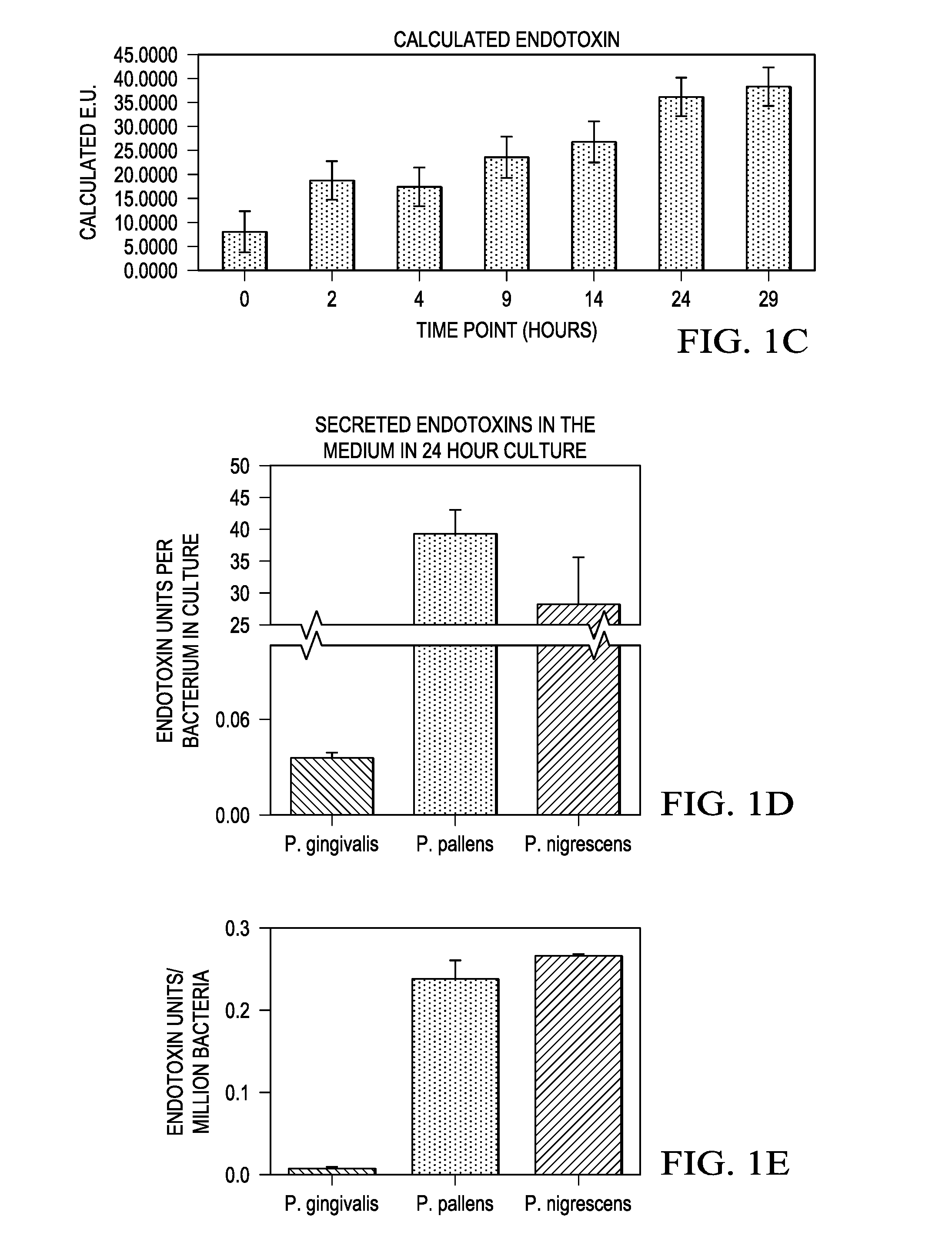Detection of oral microbial virulence factors
a technology of oral microbial virulence factor and bacterial virulence factor, which is applied in the direction of instruments, biochemistry apparatus and processes, material analysis, etc., can solve the problems of not being able to detect non-culturable species present, not being able to allow users to determine the virulence level of a specific site, and not being able to measure the toxicity of biological samples
- Summary
- Abstract
- Description
- Claims
- Application Information
AI Technical Summary
Benefits of technology
Problems solved by technology
Method used
Image
Examples
example 1
Determination of Secreted Lipopolysaccharide by Bacteria
[0117]Growth of bacteria: A 1 ml aliquot of a 24 hour culture of E. coli ATCC 8739 was used to inoculate 100 ml of Luria-Bertani (LB) broth in a 250 ml baffled flask. This culture was then incubated at 37° C. with agitation (220 rpm) and sampled at 30 minute intervals. Samples were assessed for turbidity (OD600) in a SpectraMax platereader M3 (Molecular Devices, Sunnydale, Calif.), which is one method of monitoring the growth and physiological state of microorganisms. The sample turbidity was then recorded and the samples were centrifuged at 5000 RPM for 10 min at room temperature. The supernatant, thereinafter referred to as “supernatant of bacterial culture”, was subsequently analyzed for LPS content using the procedure as described below.
[0118]Twenty ml aliquots of MTGE broth (Anaerobe Systems, Morgan Hill, Calif.) were inoculated with P. gingivalis ATCC 33277, P. pallens ATCC 700821, or P. nigrescens ATCC 25261. These cultu...
example 2
LAL Assay to Quantify Virulence Factors in Dental Plaques
[0124]Seven panelists, with at least three bleeding sites, took part in the testing. A licensed dental hygienist collected subgingival plaque samples. Samples were taken at the tooth / gum interface (buccal surfaces only) using care to avoid contact with the oral soft tissues. Six subgingival plaque sites were sampled from each panelist (3 healthy and 3 unhealthy sites). Unhealthy teeth had bleeding sites with pockets greater than 3 mm and healthy sites had no bleeding with pocket depth less than 2 mm Prior to sampling, panelists were instructed to abstain for 12 hours from oral hygiene and refrain from eating, chewing gum, drinking (except small sips of water). Next, panelists had their marginal plaque collected with a curette at the sampling sites. Then, from the same site, subgingival plaque samples were collected with 3 consecutive paper points as shown in FIG. 1F. The sampling sites were isolated with cotton rolls and gentl...
example 3
Technology Development Using the LAL Assay Kit
[0127]The LAL assay, as described in EXAMPLE 1, was modified for development of technology which inhibits LPS from activating a proenzyme in the LAL assay. The Thermo Scientific Pierce LAL Chromogenic Endotoxin Quantitation Kit is a quantitative endpoint assay for the detection of LPS, which catalyzes the activation of a proenzyme in the modified Limulus Amebocyte Lysate (LAL). The activated proenzyme then splits p-Nitroaniline (pNA) from the colorless substrate, Ac-Ile-Glu-Ala-Arg-pNA. The product pNA is photometrically measured at 405-410 nm. If SnF2 binds to LPS, the latter can't react with the proenzyme in the LAL kit. Consequently, the proenzyme is not activated, and the colorless substrate Ac-Ile-Glu-Ala-Arg-pNA will not split and no color product is produced. P. gingivalis LPS 1690 (1 ng / ml), or E. coli LPS (1 ng / ml), and stannous fluoride and other materials (50 and 500 μM), as listed in TABLE 2, were dissolved in endotoxin-free ...
PUM
| Property | Measurement | Unit |
|---|---|---|
| depth | aaaaa | aaaaa |
| depth | aaaaa | aaaaa |
| temperature | aaaaa | aaaaa |
Abstract
Description
Claims
Application Information
 Login to View More
Login to View More - R&D
- Intellectual Property
- Life Sciences
- Materials
- Tech Scout
- Unparalleled Data Quality
- Higher Quality Content
- 60% Fewer Hallucinations
Browse by: Latest US Patents, China's latest patents, Technical Efficacy Thesaurus, Application Domain, Technology Topic, Popular Technical Reports.
© 2025 PatSnap. All rights reserved.Legal|Privacy policy|Modern Slavery Act Transparency Statement|Sitemap|About US| Contact US: help@patsnap.com



